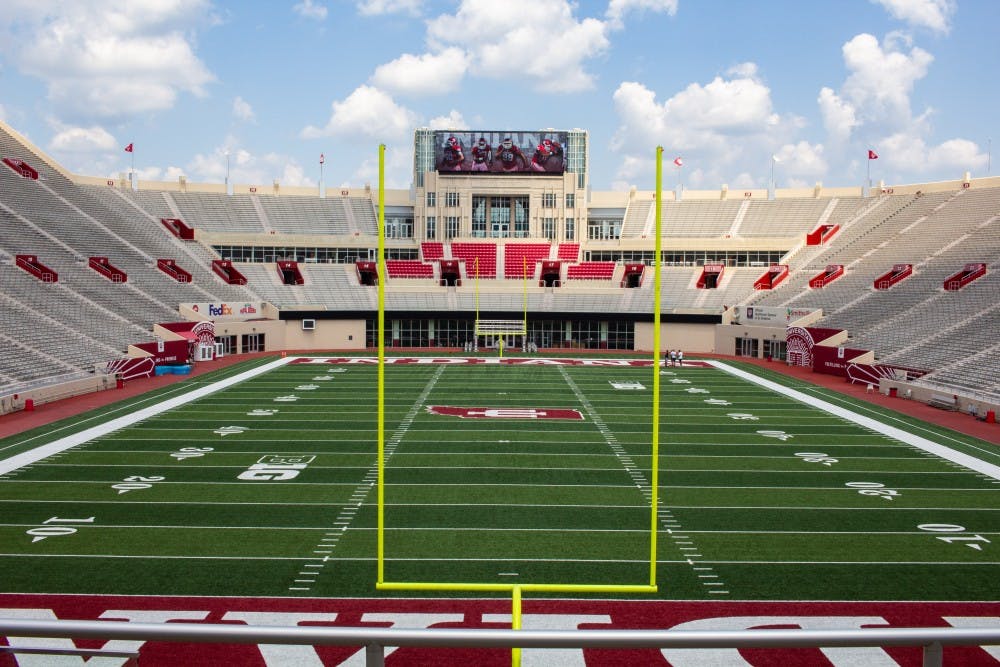Construction crews descended on Memorial Stadium last year with a simple task — to build a lavish new toy for IU’s athletics department.
The stadium’s south end zone was enclosed with the building of the Excellence Academy, a $53 million project featuring an academic and medical facility for IU student-athletes, which is also used by IU to generate revenue during football games as a place any patron with a ticket can watch the game from.
“It’s important that Indiana University has a football program worthy of our brand of being excellent,” IU Athletic Director Fred Glass said earlier this year. “More importantly, to have a football program worthy of having the respect of Indiana University and our fans.”
But, one question remains with the facility now in use — was this a good investment by IU in its football program?
Within the context of the stratified landscape of college football, IU is firmly in the middle tier of Football Bowl Subdivision programs. Taking a look around the country at similar programs to IU, the answer of whether the stadium renovations were a good investment isn’t clear-cut.
Over the last 10 years, seemingly every FBS program has upgraded its stadium.
I researched which college football teams which have been members of the FBS for the last 10 years, and from 2008 to 2018, 52 of these schools, including IU, implemented a renovation project of more than $10 million on an on-campus football stadium built before 2008.
Not all football programs or stadium upgrades can be analyzed the same, though.
The S&P+ rankings are a defining statistic to compare teams in a sport like college football, where no two schedules are equal. The rankings use five factors from a team, such as how efficiently it scores points and how consistently its defense stops opponents, to rank all 130 FBS programs against one another regardless of record.
The University of Maryland began a $50.8 million renovation project at Maryland Stadium in 2007 and also spent $200 million to convert an old basketball gym into the football team’s new indoor practice facility. These projects occurred as Maryland changed conference affiliations from the Atlantic Coast Conference to the Big Ten Conference, but the wins haven’t followed for the Terrapins.
Maryland averaged an S&P+ ranking of 75.2 during the last 10 seasons after the renovation began, winning just two bowl games. Furthermore, after the stadium renovation project, the Maryland athletic department has operated at a deficit after the cost to maintain facilities more than doubled from 2010 to 2015.
While the University of Kentucky, like IU, has been fiscally responsible with a profitable athletic department during the last decade, it has also struggled to generate victories on the gridiron.
The Wildcats have an average S&P+ ranking of 73.8 with one bowl game win since 2008, despite a $110 million renovation to Kroger Field in 2015 to improve seats, stadium concourses and the press box. But since the renovations, the Wildcats made consecutive bowl games in 2016 and 2017, and are currently ninth in the first College Football Playoff rankings of the season with a 7-1 record.
Kentucky is an outlier among teams in college football’s top conferences, though.
Vanderbilt University spent $50 million on four different projects from 2008 to 2011 to give Vanderbilt Stadium a facelift, but the Commodores only have an average S&P+ ranking of 77 from the 2012 season to now to show for it.
Rutgers University, the laughingstock of the Big Ten, owns an S&P+ ranking of 80.8 during the last decade and had to borrow $102 million in bonds and low-interest commercial paper to expand the seating capacity to 52,454 at HighPoint.com Stadium in 2009. During the 2017 season, Rutgers averaged fewer than 40,000 people per game.
Given this information, it’s impossible to say the money invested in stadium upgrades results in more wins.
Good football teams will continue to win, regardless of their stadium.
Football-focused schools like the University of Alabama, Ohio State University, the University of Oklahoma and Louisiana State University all averaged a top-13 S&P+ ranking in the country from 2008 to 2018.
They would have had these results playing in their current stadium, a high school stadium or on Mars. These results happen when an athletic department has been centered around the football program at a school for a long time.
IU is making a respectable effort to try, but facility improvements can only do so much for the team’s fortunes on the field.
The quality of the fan experience at Memorial Stadium will increase thanks to the new south end zone complex, but that’s all that can be guaranteed by it.
This is year one of the new Memorial Stadium. The promise is that in the coming years the results will follow on the scoreboard.
The wins haven’t followed for Maryland, Rutgers or Vanderbilt, and it remains to be seen if they will for IU.
cpdrummo@iu.edu
@cdrummond97




